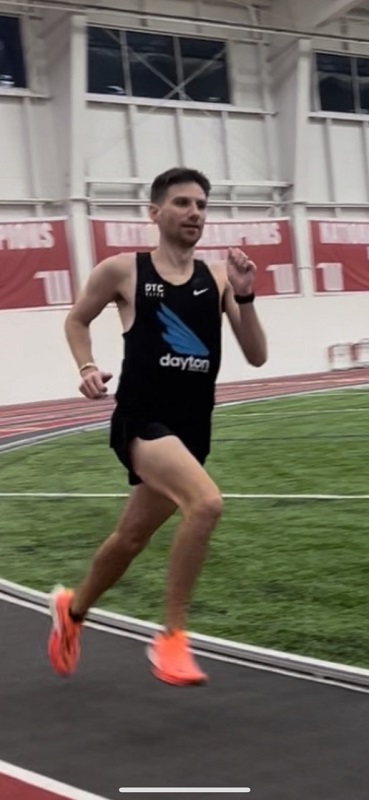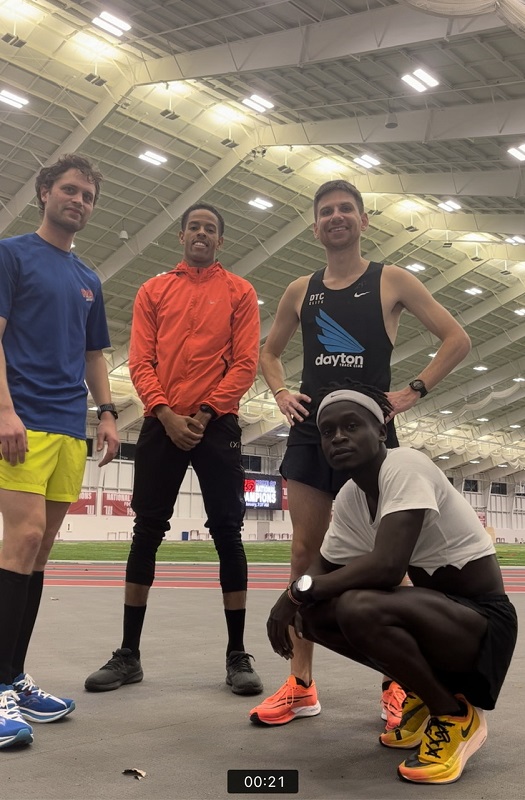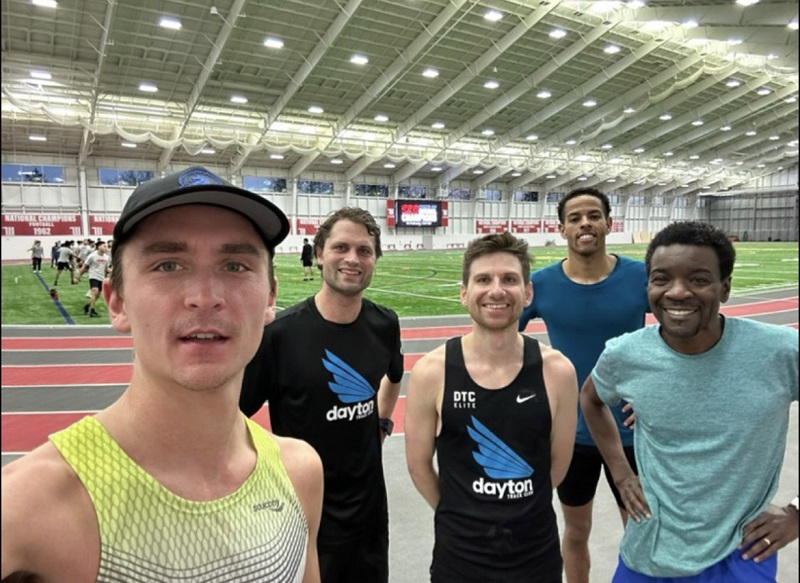The Road to Orlando: February Edition
Posted by | 02.01.2023Blog #2: February Edition
The Road to Orlando: A Monthly Running Blog Chronicling my Training and Racing Leading up to the U.S. Marathon Olympic Trials

Nothing flashy happened in the month of January. No races or monster workouts. Just solid training overall. I ran 100 miles and 3 workouts each week with a focus on speedwork. When it comes to workouts, I like using a baseball analogy. I would rather be the batter that goes for a single or double each time at the plate and has a high on-base percentage instead of the batter that swings for the fences every time and has tons of strikeouts with the occasional home run. I would say most of my workouts were singles or doubles, and this was by design. Improving fitness is a gradual process and consistency is key.
Workout details and progression
My workout days are typically Monday, Wednesday, and Saturday. On Mondays I have a lighter workout session with a couple of the top high school distance runners at Tippecanoe High School during their long run. After a solo 12 miles in the morning, I’ll run 8-10 miles with the high schoolers in the afternoon, and we’ve been incorporating 8 repetitions of 1 minute hard and 2 minutes easy during the middle portion of the run.
My second workout of the week is usually on Wednesdays at Wittenberg University’s indoor 300 meter track. A group of 6-10 runners from Dayton Track Club Elite have been attending these 6AM workouts. The first workout of the month was 16x200 meters at mile pace with double recovery. For example, if I’m running the 200 meter repeats in 30-32 seconds, then I want to rest for about 60-64 seconds before I start the next repetition. The purpose of the double recovery is to allow myself to be fully rested for the next hard effort. Note: the double recovery philosophy only applies to mile pace efforts. If the recovery time was shorter, then I likely would not be able to hit the pace or perform the desired number of repeats. My running form could also get sloppy. I made subsequent workouts more challenging by maintaining the same speed but extending the distance at that intensity. So the primary focus of the next workout was 11x300 meters at mile race pace, again with double recovery. Then I lengthened the distance again the next time with 8x400 meters. You might have noticed a trend with the main part of these workouts consisting of about 3200 meters of workout volume which is equivalent to about two miles. After the main portion of the workout, I would jog a mile and then do some additional faster running. Sometimes it was 2-3 half-marathon paced mile repeats, and sometimes it was shorter repeats than what I had just run. Later in the afternoon, I would do a very similar but shorter workout with the high schoolers—so two workouts in a single day.
My long runs have all been 20 milers with other elite runners from the Dayton area. Some of these workouts have been speed focused like the Monday/Wednesday workouts. For example, I’ve done 16x1 min hard/2 min easy a couple of times. I’ve also done a couple of marathon-specific workouts like 2x4 miles with the first three miles at marathon pace and the last one at half marathon pace. Another was 4 miles at marathon, 2 miles at half marathon, and four miles at marathon. Why the shift away from speed on these marathon-specific workouts? To be honest, I preferred to do all speed workouts this month, but compromising at times with the preferences of your workout partners is worth it in the long run.

Why focus on speed when training for the marathon?
It does seem somewhat counter intuitive. Being fast in 200-400 meters does not seem like it would correlate to being fast in a 26.2 mile race. However, there is a good rationale for this approach. I ran up to 120 miles a week leading up to the California International Marathon. My endurance was solid. How can I get faster? I could increase my training volume to 140-150 miles per week to build even more endurance, but that would be a recipe for disaster because I would likely get injured. Running that much would also eradicate my joy with the sport. Instead of increasing my mileage, I’d rather maintain my endurance while improving my speed. My ceiling potential will be higher with quicker foot speed. In fact, a study on elite 10K runners found that 72% of the variability in times could be explained by how fast they could run all out in 400 meters. At a common sense level, dedicating some time to speedwork will make marathon pace feel easier because I’ll be widening the gap between my top end speed and my marathon pace.
My overall training philosophy is to focus on speed first (after an easy base mileage phase) and then gradually make the workouts more race specific as I approach the peak marathon race. The speed workouts allow me to work on good running form and quicker leg turnover. Starting with speed also will allow me to more easily transition to the next training phase. After speed, I’ll focus on 5K/10k workouts, then half-marathon workouts, and finally full marathon workouts. By doing speed first, I only add one training stressor at a time. If I were to go from easy base building running straight into longer sustained efforts, I would be adding two stressors simultaneously: speed and endurance (blood lactate clearance). The abrupt transition would be a shock to my body, and I would likely struggle in the workouts or get injured. Now that I have developed some speed, the longer sustained efforts—say mile repeats at half marathon effort—won’t feel excessively challenging because I’ve already run significantly faster than half-marathon pace during those 200-400 meter repeats which were at mile pace. This approach also allows me to race well at various distances prior to the marathon. Once I shift my focus to longer distances, I will still incorporate fast 200s at the end of my workouts so that I can maintain the speed I built. Being able to shift gears during a longer race and tap into that speed for surges and a finishing kick will certainly come in handy.
Treadmill running
I’ll be frank; Winter weather stinks. Having training partners certainly helps because we can all be miserable in the cold together. However, there are some days where I gladly opt for the treadmill. I would rather run on the treadmill in my basement than run outside on days where it’s 10 degrees or below. I also don’t enjoy running outside when it’s slushy or icy. Not only does my risk of falling increase while outside, but I’m also forced to slow to a pace that doesn’t provide enough of a stimulus to improve my fitness. Most people have a strong disdain for the treadmill, often referring to it as the “dreadmill”. This is mostly due to the boredom of running in place and also the increased level of perceived effort. Studies have demonstrated that people perceive running on the treadmill to be more challenging than running at the same speed outside. Luckily I’ve built up a tolerance to running on the hamster wheel. I usually play some loud music or listen to a podcast. Even when the weather outside is fine, I often prefer the treadmill over running in the dark at 6AM because I can lock into a faster pace more easily. Overall, I believe running on the treadmill has improved my mental toughness, and I believe my willingness to use it gives me a competitive advantage over those who don’t use it.
Racing plans this cycle
My first race will be the ORRRC Frostbite 5 Miler on February 12. Since this is a smaller, low-profile race, I will be training through this race without backing off my training and running it more like a workout at half-marathon pace.
The Bockfest 5K in Cincinnati on March 4 will be my first real race. This race is part of an elite racing series competition between the top running clubs in the state of Ohio: Dayton Track Club Elite, Columbus Running Company, Cincinnatus Elite, and Dave’s Racing Team (Toledo). Bockfest will be the first of a total of five races in the series. The other races in this series will occur between June and October. The ORRRC Little Miami 10 Miler is the day after Bockfest, and I will likely run that race as a workout.
On April 1st I’ll be racing 10 kilometers on the track at a collegiate meet in Cincinnati. I would like to challenge for the win and/or improve upon my 10K personal record of 29:43 from Minster in October of 2022.
At some point I also want to run a 5K on the track at a collegiate meet and improve upon my 14:42 5K PR I set in college in 2013. I imagine I’ll run this race shortly before or after the 10K in Cincinnati.
My peak race of the training cycle will be the Toledo Glass City Marathon on Sunday, April 23rd. My goal will be to contend for the win and chase after the course record of 2:20:58. Although I ran 2:17:14 at CIM, every course is different. I know Toledo is very flat, but it also has a lot of turns which slows you down. You also never know what the weather will be like, and you never know who is going to show up and race.
Why not race in January or February? I would rather focus on training and improving my fitness. From experience I have a good feeling of what times I could run at various distances, so I don’t need the feedback from a race to tell me what shape I’m in. Could I possibly run a 1-5 second PR right now I’m the 5K? Certainly, but I would rather wait to race when I know I’m capable of running a 10-15 second PR. The races I care most about are in March and April, and I would rather not taper for races in January or February. I also raced 15 times last year and could use a break from racing.

Self-coached
I take pride in being self-coached. Running seems like a pretty straightforward sport, but there is a lot of debate over the optimal way to train and improve. In high school I had three different distance coaches between cross country and track. I also had three distance coaches in college. Having so many coaches exposed me to many different workout types and training methodologies. Since college I’ve experimented with different approaches, and I’ve also tagged along on some of my friends’ and training partners’ workouts. While I don’t have a science or sports exercise background, I’ve made an effort to become a student of the sport and learn as much as I can about running physiology and best practices. I’ve read books and studies, listened to podcasts featuring pro runners and coaches, and analyzed the training of pro and sub-elite runners. I’ve also served as an assistant coach at the high school level. After many racing highs and lows and injuries, I’m finally at a point where I feel confident that what I’m doing is the correct approach for me. Training with other elite Dayton runners has elevated my running tremendously, but there are times we don’t agree with what workout to do. Over time I have established more credibility with the group, and there seems to be more buy-in with my approach. However, just because my training is working for me does not mean it is the best approach for everyone else. So there is a good amount of compromising and doing a workout someone else wants to do from time to time. Once my competitive running career is over, I would like to get into private coaching and help other runners take their running to the next level.
A typical day
Most days I wake up around 5:00 or 5:15 to prepare for a 6AM run. If it is a workout day, I try to foam roll, use the massage gun, rope stretch, and take a shower beforehand. People always think it’s weird that I take a shower before I run. I’m not a coffee drinker, so I say that it’s my version of coffee that wakes me up and makes me feel refreshed and alert. If it’s not a workout day, I play the game Wordle until I can figure out the word for the day. Then I feed my cat and either hop on my treadmill or link up with some friends to run outside.
My workday consists of meetings, emails, preparing for meetings, and more meetings. I am the project manager for several projects to automate internal business processes. I work with the customer to solidify the requirements, and I facilitate the weekly status meetings and testing sessions. When I’m not in a meeting, I’m taking care of my very needy dogs. They are always so well behaved during meetings and never act in a disruptive manner (sarcasm). This is my only complaint about working from home. However, one of the big upsides of working from home is the fact I can wear my Normatec Recovery boots which massage my legs and keep them feeling good.
After work I take the dogs for a second walk, interact with the cat, and make sure everyone is fed. Then it’s usually a second run. I’m often starving after this second run and need to grab dinner. My wife works ten hour shifts and doesn’t get home until 7PM, so I often need to eat without her. Once she gets home it’s family bonding time for a couple of hours, but I usually need to be in bed by 9PM so I can wake up by 5AM. I’m very appreciative of my wife’s support and understanding of the lifestyle I need to lead in order to reach my goals. Although we don’t get to spend much time together Monday through Friday, we make up for it on the weekends. During the weekend I only run in the mornings.
Closing
Hopefully this blog has been somewhat engaging. I enjoy writing them and do my best to give you the inside scoop of the non-glamorous life of a national-level marathoner. Once I start racing I’ll be able to write race recaps which should be a more lively read. If there are topics you would like me to touch on more, or if you have specific questions, please feel free to let me know and I’ll try to address them in my next blog. Thanks again to Runners Plus and Xcel Sports Medicine for sponsoring me. Their continued support allows me to confidently train at a high level. Cheers!


